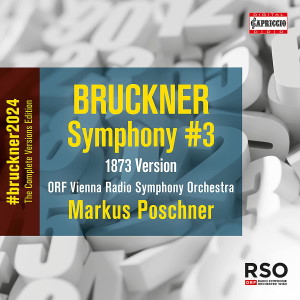
Anton Bruckner (1824-1896)
Symphony No 3 in D minor (Original 1873 version, ed. Nowak)
ORF Vienna Radio Symphony Orchestra/Markus Poschner
rec. 2022, Radio Kulturhaus, Vienna, Austria
CAPRICCIO C8086 [57]
This series of all the written versions of the Bruckner symphonies uses two orchestras, the ORF Radio Symphony Orchestra and Markus Poschner’s own Bruckner Orchestra Linz. Perhaps it would have been more appropriate to record with the conductor’s Linz ensemble but the ORF Radio Symphony is clearly an outstanding ensemble.
Several Bruckner symphonic cycles are being recorded to commemorate the composer’s birth anniversary in 2024, and this cycle by Markus Poschner claims to be the most all-embracing in offering nineteen versions on CD. Of course, there is a significant legacy of Bruckner recordings by Eugen Jochum (with the Dresden Staatskapelle on EMI, and DG with the BRSO and Berlin Philharmonic), Karajan, Celibidache, Haitink, Blomstedt, and extensive cycles by Schaller and Young, but only the latter include the ‘Study’ and ‘Nullte’ symphonies.
Bruckner’s Third Symphony was revised more than any other and exists in three manuscript versions, plus a separate manuscript of the Adagio, with the revised fragments from 1874, 1875 and 1876. The original score in Bruckner’s hand exists only in parts, because the composer removed many pages in his later revisions. Bruckner asked his copyist to prepare two scores of his first version. It was one of these copies that he sent to Wagner with his dedication. Leopold Nowak used this Bayreuth score that is used for Poschner’s recording here.
Professor Hawkshaw points out in his extensive notes: ‘Bruckner was experimenting with expanding the dimensions and expressive power of the genre to unprecedented lengths and depths. It was a work in progress, a fact he himself acknowledged with their subsequent revisions. As the longest at the outset, and the most revised, the Third has not always been treated well by critics.’
The great Bruckner champion, Robert Simpson called the Third the weakest of his symphonies, yet after acquaintance with the original score, he changed his opinion stating he had ‘to reconsider everything I wrote about [the Third Symphony]; it is now clear to me that the revisions … of 1877-78 and 1889-90 … show that Bruckner did not know what he had achieved in the 1873-74 version … the score that Wagner accepted with justifiable enthusiasm.’
Hawkshaw continues in his notes: ‘For the purposes of this collection, the performers have adopted the definition of “version” formulation by the editors of the New Anton Bruckner Complete Edition […] now in preparation under the auspices of the Austrian National Library. […] The collection does not include any of the first editions of symphonies that were printed without the composer’s involvement – the so-called Schalk or Löwe versions.’
The opening bars are exciting, and the splendid entry by the trumpet allows the conductor to achieve greater intensity in this passage, developing the sense of expectation. The unfamiliar swift tempo adopted by Poschner is justified by what he creates. This movement is supposed to portray God and Nature, and there is much greatness in Poschner’s interpretation. At 12:20, he conjures a beautifully judged passage that creates the vision as if a veil falls away. There are vivid harmonies from the brass group and the timpani, and again he takes a fast tempo as if sprinting to the end of this impressive opening movement.
In the Adagio, the conductor handles the tempos and themes wonderfully by obtaining terrific string playing, the woodwind in particular being outstanding. He takes a quick pace and develops an exciting build-up to the brass chorale with glorious horn intonation. In the Scherzo, Poschner creates a playfully gracious mood in the Ländler. The lively tone continues in the Finale. Allegro, with superbly executed orchestral playing and again, the brass group is exceptional. Poschner makes his tempos work very well by generating a build-up of excitement with spirited Ländler leading to a remarkable culmination to this great symphony.
The CD is enclosed in a cardboard sleeve with a 28-page booklet with extensive notes in English and German by Professor Hawkshaw of Yale School of Music, the Artistic Director of the Bruckner Linz Orchestra, Norbert Trawäger, and Poschner’s thoughts on Bruckner. There is a history of the ORF Vienna Radio Symphony Orchestra, together with black and white photos of the performers. The recording was set down in two different venues over several days, and there is no compromise in the excellent sound quality.
This release is obligatory for those who already have the previous discs in this series and the growing number of Bruckner enthusiasts.
Gregor Tassie
Previous review: Ralph Moore (October 2022)
Help us financially by purchasing through





















